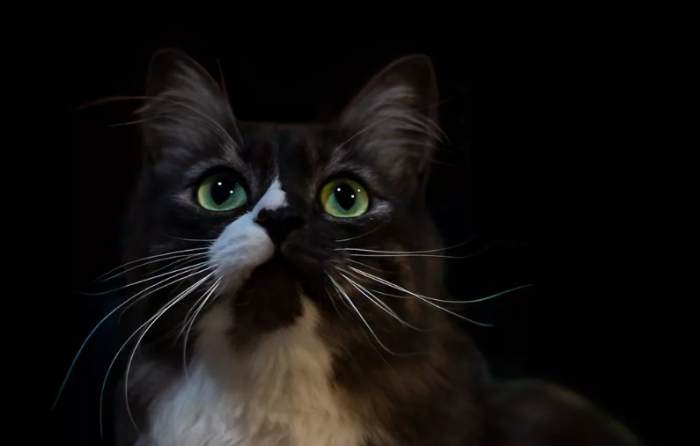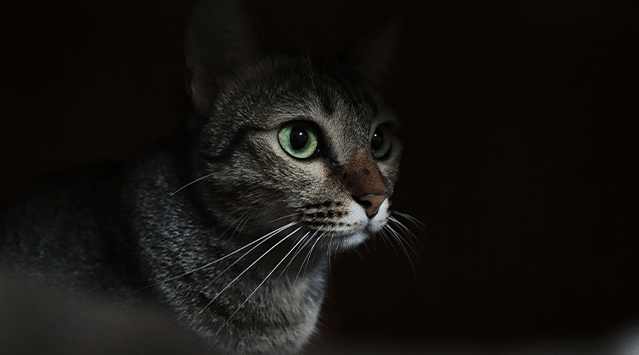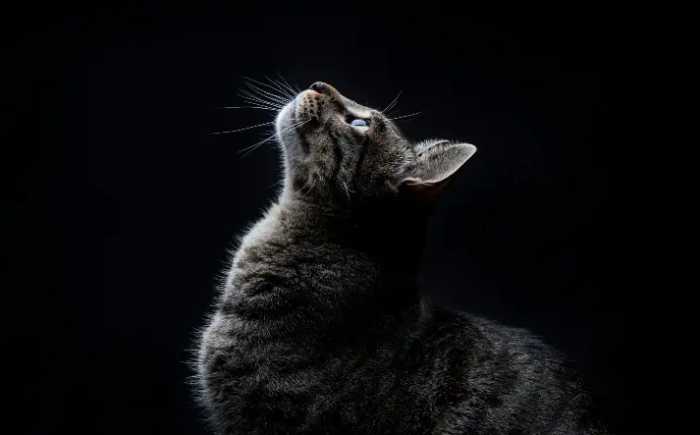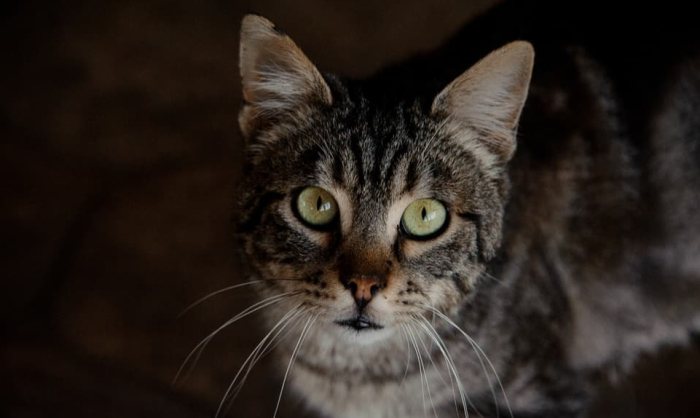Advertisements
Can Cats See in the Dark? Evolution, Night Vision Facts & How They See the World
Can cats see in the dark? Discover how cats' night vision evolved, 5 fascinating facts about their eyes, and how cats see the world differently than humans. Learn the science behind feline vision!
Table of Contents
Hey there, fellow cat lovers! If you’ve ever caught your furry friend prowling around the house at 3 a.m. like a tiny, fluffy ninja, you’ve probably wondered: Can cats see in the dark? Spoiler alert: They’re not quite Batman, but they’re close. Today, we’re breaking down everything you need to know about your cat’s night vision, from evolution to eye facts, and even how they perceive the world around them. So grab a coffee (or a cat treat), and let’s dive in!
Can Cats See in the Dark?
Let’s cut to the chase: Yes, cats can see in the dark, but it’s not like they’re walking around with night-vision goggles. Their vision is adapted for low-light conditions, not total darkness. Here’s how it works:
1. The Rods and Cones Dance
Cats’ eyes have way more rod cells than humans do. Rods are the cells responsible for detecting light and motion, which is why your cat can spot a moth fluttering by even when you’re squinting. On the flip side, they have fewer cone cells, which handle color vision and detail. So, while they’re great at seeing in the dark, they’re not winning any art awards for color perception.
2. The Tapetum Lucidum: Their Secret Weapon
Ever noticed your cat’s eyes glowing in the dark? That’s the tapetum lucidum, a reflective layer behind their retina that bounces light back through the rods, giving them a second chance to absorb it. It’s like a built-in flashlight for their eyes! This is why cats can see in the dark about six to eight times better than we can.
3. Pupil Power
Cats’ pupils are like adjustable camera lenses. In bright light, they shrink to slits to protect their sensitive eyes. In low light, they dilate into huge circles, letting in as much light as possible. It’s like they’re constantly adjusting their “vision settings” based on the environment.
4. But What About Total Darkness?
Here’s the catch: Can cats see in complete darkness? Nope. No creature on Earth can see in pitch black. Cats need some light—even a tiny bit—to navigate. So, if you’re wondering, Do cats need light at night to see? The answer is yes, but they don’t need much. A moonlit room or a streetlamp outside is plenty.
The Evolution of Cats' Night Vision
Cats didn’t just wake up one day with superhero night vision. It’s the result of millions of years of evolution, shaped by their hunting habits and survival needs.
1. From Prey to Predator
Early cats were small, nocturnal hunters who needed to sneak up on rodents and birds under the cover of darkness. The evolution of cats' night vision was driven by the need to see in low light without alerting their prey. Over time, their eyes adapted to maximize light sensitivity, giving them an edge in the dark.
2. The Wild Ancestors
Wild cats like lions, tigers, and leopards also rely on night vision for hunting. While domestic cats are smaller and less likely to hunt large prey, they’ve inherited the same evolution of cats' night vision from their wild cousins. It’s like they’re carrying a piece of the jungle in their DNA.
3. The Role of the Tapetum Lucidum
The tapetum lucidum isn’t unique to cats—many nocturnal animals have it, including dogs, deer, and even some fish. But in cats, it’s especially pronounced, giving them that iconic glow-in-the-dark look. The evolution of cats' night vision fine-tuned this layer to maximize light reflection, making them the ultimate nighttime hunters (even if their “prey” is now just a laser pointer).
4. Pupil Shape Matters
Cats’ vertical pupils aren’t just for show—they’re another evolutionary adaptation. Vertical pupils help cats judge distance and depth more accurately in low light, which is crucial for pouncing on unsuspecting toys (or your feet under the covers). The evolution of cats' night vision favored this shape because it gives them an advantage in dimly lit environments.
5. Domestication’s Impact
Even though domestic cats don’t need to hunt for survival, their night vision remains intact. Why? Because the evolution of cats' night vision happened over millennia, and domestication hasn’t had enough time to erase it. Plus, let’s be real—who wants a cat that can’t stalk you at 3 a.m.?
Five Facts About Cats' Eyes
Cats’ eyes are fascinating, and not just because they glow in the dark. Here are five quirky facts you might not know:
1. Fact 1: They See in a Different Color Spectrum
While humans have three types of cones (red, green, and blue), cats only have two (blue and green). This means cats can see in the dark, but their color vision is limited. They likely see the world in muted blues, greens, and yellows, with reds and pinks appearing as shades of gray. So, that red laser dot? Your cat probably sees it as a dull gray blob—but they chase it anyway because… cats.
2. Fact 2: Their Whiskers Are Part of Their Vision
Okay, this one’s a bit of a stretch, but hear me out. Cats’ whiskers (vibrissae) are super sensitive and help them navigate in the dark by detecting changes in air currents and nearby objects. It’s like they have a built-in radar system to complement their night vision. So, while it’s not technically part of their eyes, it’s still a crucial part of how they “see” the world.
3. Fact 3: They Can’t Focus on Close-Up Objects
Cats are nearsighted, meaning they can’t see things up close as clearly as we can. Their vision is optimized for detecting movement and shapes at a distance, which is perfect for hunting. But if you try to show your cat a photo on your phone, they’ll probably just stare blankly—not because they’re unimpressed, but because they can’t focus on it. Cats can see in the dark, but close-up details? Not so much.
4. Fact 4: Their Eyes Change Color with Age
Kittens are born with blue eyes because their melanin (the pigment that determines eye color) hasn’t fully developed yet. As they grow, their eye color may change to green, gold, or copper. Fun fact: Some cats, like Siamese, keep their blue eyes into adulthood due to a genetic quirk. But no matter the color, their night vision remains top-notch.
5. Fact 5: They Have a Third Eyelid
Cats have a nictitating membrane, or “third eyelid,” that protects their eyes from debris and helps keep them moist. You might not notice it unless your cat is sleepy or sick, but it’s there, working hard to keep their vision sharp. And yes, it’s another adaptation that helps them see in the dark (or at least, see clearly in general).

How Cats See the World
So, what does the world look like through your cat’s eyes? Let’s break it down:
1. A World of Motion
Cats are masters at detecting movement, thanks to their high rod-to-cone ratio. To them, a slowly waving feather toy is like a neon sign in the dark. How cats see the world is all about motion—they’re hardwired to notice even the slightest twitch, which is why they’ll pounce on a bug you didn’t even know was there.
2. Limited Color, But Great Contrast
While cats don’t see the same vibrant colors we do, they’re excellent at distinguishing between light and dark. This helps them spot prey (or your feet under the blanket) in low light. How cats see the world is like a high-contrast black-and-white movie with occasional splashes of blue and green.
3. Wide-Angle Vision
Cats have a wider field of view than humans—about 200 degrees compared to our 180. This gives them a panoramic view of their surroundings, perfect for spotting predators (or that pesky laser dot) from any angle. How cats see the world is like having a built-in surveillance system.
4. Depth Perception Challenges
Because their eyes are set wider apart than ours, cats have excellent depth perception for judging distances when jumping or pouncing. However, they’re not as good at gauging depth when looking straight ahead, which is why they sometimes misjudge the distance to a windowsill and end up doing a face-plant. How cats see the world is a mix of precision and occasional clumsiness.
5. Nighttime is Their Playtime
Cats are crepuscular, meaning they’re most active at dawn and dusk. Their night vision is perfectly suited to this schedule, allowing them to hunt, play, and explore when the light is low. So, if your cat is zooming around the house at 4 a.m., it’s not because they’re trying to annoy you—it’s just how how cats see the world (and live in it).
Q&A: Your Burning Questions Answered
Let’s wrap things up with some quick answers to your most pressing questions:
Can cats see in complete darkness?
Nope. They need at least a tiny bit of light to navigate. Think of them as “low-light champions,” not “pitch-black superheroes.”
Do cats need light at night to see?
Yes, but not much. A moonlit room or a streetlamp outside is enough. They’re adapted to see in dim conditions, not total darkness.
Should I leave a light on for my cat?
Unless your cat is elderly or has vision issues, they probably don’t need a nightlight. Their eyes are built for low light, and they’re used to navigating in the dark. Plus, leaving a light on might disrupt their sleep cycle (cats are crepuscular, meaning they’re most active at dawn and dusk). So, Should I leave a light on for my cat? Probably not—unless you want a wide-awake kitty at 2 a.m. demanding breakfast.
What colors can cats see in the dark?
Cats don’t see colors in the dark—they rely on light sensitivity and motion detection. In daylight, they see muted blues, greens, and yellows, but reds and pinks appear gray.
And there you have it! Can cats see in the dark? Yes, but with some caveats. The evolution of cats' night vision has turned them into low-light legends, and their eyes are full of quirks that make them the unique creatures we love. So, the next time your cat stares at a wall like it’s haunted, remember—they’re just seeing the world in their own special way. Happy cat-watching!
Leave a Message